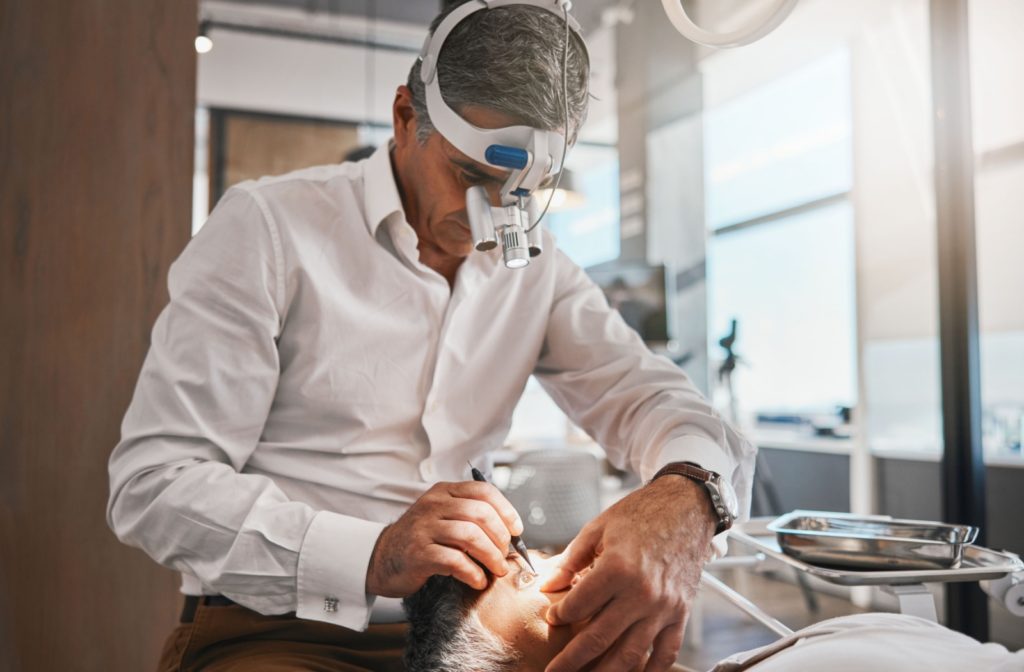Cataracts are a common eye condition that many people face as they age. Eventually, cataract surgery is the answer to getting rid of them. Fortunately, a cataract cannot come back once the clouded lens is removed. But it’s important to note that another condition called posterior capsule opacification (PCO) can develop, which has similar symptoms to a cataract.
It’s essential to see your eye doctor if you’ve had cataract surgery and notice some symptoms like halos around lights returning. This could be PCO or another condition entirely that your optometrist needs to address.
Understanding Cataracts
Cataracts occur when your eye’s lens becomes cloudy, leading to blurry vision. This cloudiness happens due to protein clumping together, which can affect your vision over time. The condition is common among older adults and can significantly impact daily activities like reading, driving, or even recognizing faces.
Causes & Risk Factors
Age is the biggest risk factor in developing cataracts. But several factors, ranging from environmental to medical, can contribute to the development of cataracts:
- Aging: The most common cause of cataracts is aging. As we get older, the proteins in the eye’s lens can start to break down and clump together, forming cloudy areas.
- Medical conditions: Diseases like diabetes can increase the risk of cataracts. High blood sugar levels can cause changes in the lens, leading to cloudiness.
- Lifestyle factors: Smoking, excessive alcohol consumption, and prolonged exposure to UV rays can also contribute to the formation of cataracts. Leading a healthy lifestyle can help reduce these risks.
Understanding these risk factors can help you take proactive steps to protect your eye health. Regular eye checkups and a healthy lifestyle are key to maintaining clear vision.
Signs & Symptoms
Cataracts often develop slowly, making it easy to overlook early symptoms. But recognizing these signs can lead to early diagnosis and treatment:
- Blurry vision: One of the most common signs of cataracts is blurry vision. It may feel like you’re looking through a foggy or cloudy window.
- Sensitivity to light: Bright lights may become glaring, and you might experience increased sensitivity to light. This can make activities like driving at night particularly challenging.
- Fading colors: Colors may appear less vibrant or more yellowed. You might notice that things look duller than they used to.
If you experience any of these symptoms, seeing an eye doctor is essential. Early detection can help manage the condition more effectively and maintain your quality of life.
Treating Cataracts
Treatment options for cataracts depend on the severity of the condition. Stronger glasses or magnifying lenses may help improve vision in the early stages. Once a cataract interferes significantly with daily activities, surgery is often recommended.
Cataract surgery involves removing and replacing the cloudy lens with a clear artificial lens. This procedure is highly successful and is one of the most commonly performed surgeries in the United States.
Can Cataracts Come Back After Surgery?
Many people wonder if cataracts can come back after surgery. The short answer is no. Once the cloudy lens is removed, it cannot grow back. But there is a condition known as posterior capsular opacification (PCO), often called secondary cataracts, which can cause similar symptoms.
What Is Posterior Capsule Opacification?
PCO occurs when the back of the lens capsule, which holds the intraocular lens (IOL) in place, becomes cloudy over time. This can happen months or even years after the initial cataract surgery and can lead to blurred vision, similar to the symptoms of cataracts.
How Is PCO Treated?
The treatment for PCO is relatively simple and involves a quick, painless laser procedure called YAG laser capsulotomy. This procedure can restore clear vision by opening the cloudy capsule, allowing light to pass through unobstructed.

Preventive Measures & Lifestyle Changes
Cataracts can’t always be prevented, but there are certain things you can incorporate into your life to help lower your risk.
Healthy Diet
Consuming a diet rich in antioxidants can help maintain eye health. Foods like leafy greens, carrots, and fish high in omega-3 fatty acids are excellent choices.
Protect Your Eyes
Wearing sunglasses that block UV rays can significantly reduce the risk of cataract development and recurrence. Additionally, using protective eyewear during activities that could lead to eye injuries is essential.
Regular Exercise
Engaging in regular physical activity can improve overall health and reduce the risk of conditions that may contribute to cataract development, such as diabetes and hypertension.
The Importance of Regular Eye Checkups
Eye examinations aren’t just for when something goes wrong with your vision or means to update your eyeglasses prescription. Regular eye exams are crucial for detecting cataracts and other eye conditions early. Early treatment can prevent the progression of cataracts and help you maintain optimal vision.
The American Academy of Ophthalmology recommends that most individuals get a comprehensive eye examination every 1 to 2 years. But this can vary based on age and other risk factors. You should always follow your eye doctor’s recommendations as they consider your unique situation.
Book Your Next Eye Exam Today
Cataracts are a common condition that can significantly impact your vision and quality of life. While cataracts themselves cannot return after surgery, the possibility of developing PCO, or secondary cataracts, exists.
Contact our team at Total Vision Seal Beach if you’re experiencing a return of symptoms after cataract surgery. One of our experienced eye doctors can examine your eyes to determine what’s happening.




